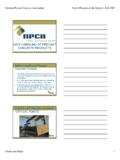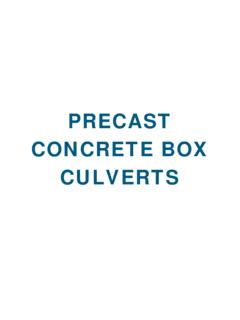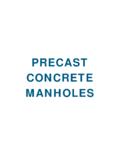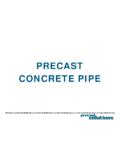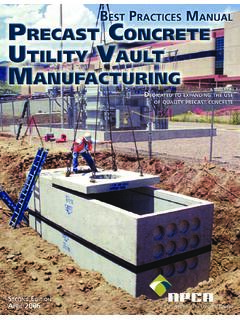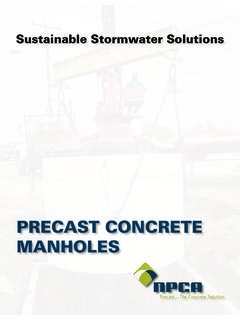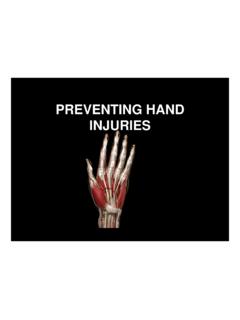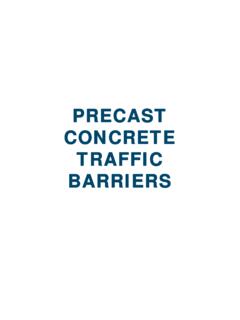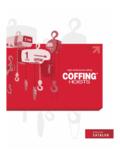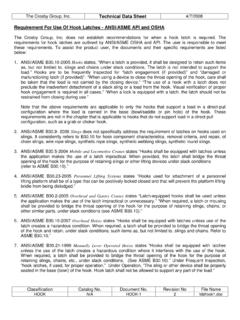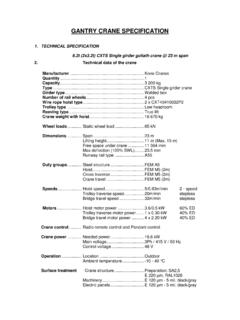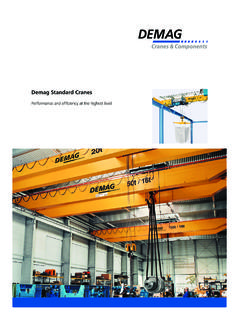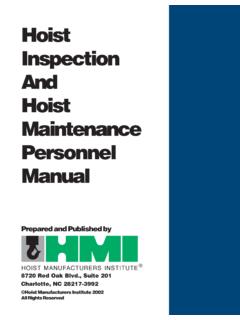Transcription of Notice Overhead Crane Safety and Inspection Requirements
1 1 Overhead Crane Safety andyInspection RequirementsNotice It is the responsibility of the Owner/User to install, inspect, test, maintain, and operate a Crane or associated lifting equipment in accordance with the applicable volume of the ANSI/ASME B30 Safety Standard, OSHA Regulations, and ANSI-NFPA 70, National Electric Code and local regulations and laws. If the Crane or associated lifting equipments is installed as part of a total lifting system, it is also the responsibility of the owner/user to comply with the applicable ANSI/ASME B30 volumes that address other types of equipment used in the it is a responsibility of the Owner/User to require all personnel who install inspect testFurther, it is a responsibility of the Owner/User to require all personnel who install, inspect, test, maintain.
2 And operate a Crane or associated lifting equipment to read and to comply with the contents of the instruction manuals furnished by the manufacturer of the Crane or associated lifting equipment, and the applicable portions of the volume of the ANSI/ASME B30 Safety Standard, OSHA Regulations, and the ANSI/NFPA 70, National Electric Code. If the Crane or associated lifting equipment is installed as part of a total lifting system, the applicable ANSI/ASME B30 volumes that address other types of equipment used in the systems must also be read and followed by all personnel. Tagged Crane or Hoist Control Devices BrakesDaily Operator Inspection Requirements Hook Hook Latch Reeving Limit Switches Oil Leakage Unusual SoundsDaily Operator Inspection Reuirements Tagged Crane or Hoist Check that the Crane or hoist is not tagged with an outoforder signan out-of-order Operator Inspection Requirements Control Devices Check that all motions agree with control device markings , Up/Down/ Operator Inspection Requirements Brakes (Travel) Check that all motions do not have excessive drift and that stoppingdrift and that stopping distances are normal (approx.)
3 10% of high speed travel. Hoist Brakes No drift Operator Inspection Requirements Hook Check for damage, cracks, nicks, gouges, deformity of the throatdeformity of the throat opening, wear on saddle or load bearing point, and twist. Refer to the manual furnished by the original manufacturer of the Crane or Operator Inspection Requirements Hook Latch Check that hook latch, if provided, is not missing pgand that it operates Operator Inspection Requirements Wire Rope Broken Wires Excessive Wear Kinks Crushing Stretching Birdcaging Rope MeasurementWire Rope Inspection Broken Wires 10 wires in one rope lay 5 wires in one strand in one rope layWire Rope Inspection Excessive Wear Loss of 1/3 of the rope diameter of individual Rope Inspection Kinks3 Wire Rope Inspection CrushingWire Rope Inspection StretchingWire Rope Inspection BirdcagingWire Rope Inspection How to Measure The components of a wire rope each have a small but definite size tolerance.
4 Therefore, the rope itself must have a diameter at least equal to the nominal, or catalog, size never Rope Inspection Replace any wire rope or red tagif you observe any of these diti!conditions!Daily Operator Inspection Requirements Load Chain Check load chain, including end connections forconnections for excessive wear, twist, distorted links or stretch, beyond the manufacturer s Operator Inspection Requirements Reeving Check that the wire rope or load chain is properly reeved and that rope or load chain parts are not twisted about each other. Make sure wire rope is properly seated in drum Operator Inspection Requirements Limit Switches Check that the upper limit device stops lifting motions of the hoist load block before striking any part of the hoist or cranecrane.
5 Caution: exercise extreme care during this test to avoid striking any part of the hoist or trolley with the hoist load block or lift beam in the event of a faulty limit Operator Inspection Requirements Oil Leakage Check for any sign of oil leakage on the gcrane and on the floor area beneath the Operator Inspection Requirements Unusual Sounds Check for any unusual sounds such as Squealingqg Grinding Unusual vibration from the Crane or hoist mechanism while operating the Crane and Operator Inspection Requirements Warning and Safety Labels and Warning Devices Check that warning and Check that warning and
6 Other Safety labels are not missing and that they are legible. Check that audible and visual warning devices are Inspection A Periodic Inspection is a detailed visual and operational Inspection whereby individual components are examined to determine their condition. The Periodic Inspection is performed as often as quarterly based on service, environmental and application factors as determined by a qualified person or as outline in the following Inspection Chart(as required by OSHA)ASME B30 2 Number of Shifts Operated per DayASME Class1 Shift2 Shifts3 ShiftsNormalANNUALANNUALANNUALH eavyANNUALSEMI-ANNUAL TO ANNUAL SEMI-ANNUALS evereQUARTERLYQUARTERLYQUARTERLYF requency of InspectionPeriodic Inspection ItemsRequired by and and , Axles, Wheels, (holding and control)(g)
7 , Electric, Hydraulic, or Gasoline Powered Generating and and End and Runway DevicesPeriodic Inspection ItemsRequired by members, such as girders, end trucks, footwalks, trap doors, ladders, handrails, trolley frame cab etcframe, cab, etc. Check for deformed, cracked, corroded or unsecured members. Are foot walks free of debris, grease, Does cab have a fire extinguisher, proper type?Periodic Inspection ItemsRequired by and Labels Check for proper capacity labels. Are they legible from the floor?legible from the floor? Are warning signs in place and legible? Was cranes test loaded?
8 Did you record in your records?Periodic Inspection ItemsRequired by Points Check for loose/broken bolts or rivets Check forrivets. Check for cracked or insufficient Inspection ItemsRequired by and Drums Check for worn grooves, worn groove gglands, sharp edges, and Inspection ItemsRequired by , Axles, Wheels, Couplings Check for worn Check for worn, cracked bent or broken parts. Check for loose/missing Inspection ItemsRequired by (Holding and Control) Check for excessive wear and proper adjustment on brake system parts, linings, pawls and ratchets. Check for proper functioning of electric control Inspection ItemsRequired by , Gauges or Other Devices Check for load, wind, and other indicators over their full range, re-calibrate as Inspection ItemsRequired by Check for excessive wear of chain drive sprockets and excessive chain stretch.
9 Open gearbox Inspection covers and check for gear teeth wear and proper Inspection ItemsRequired by OSHAE lectrical Components Check all electrical apparatus for signs of pitting or any deterioration of controller contactors, limit switches, pushbutton stations, motor slip rings, brushes, resistors. Check for any loose wire connections for damaged wiring. Check for evidence of overheating. Make sure door or cover closed Inspection ItemsRequired by OSHA Electrical Components Controller contactors Limit switches Push button stations Push button stations7 Periodic Inspection ItemsRequired by OSHA Electrical Components Motor slip rings Brushes Resistors ResistorsPeriodic Inspection ItemsRequired by and Guards Check that all covers or guards are in place, gpsecure, and Inspection ItemsRequired by and End Stops Check all bumpers and dfdend stops for damage.
10 Check for proper restraints and obvious under sizing or improper energy absorption Inspection ItemsRequired by and Runway Rail Check rails and fti di ffastening devices for looseness, gaps, misalignment, Inspection ItemsRequired by and Runway RailPeriodic Inspection ItemsRequired by Structures Check runway structure for proper anchors loose boltedanchors, loose bolted connections, corrosion, cracked or deformed Inspection ItemsRequired by System Check the conductor systems ffor: Alignment Fastening Splices Power feeds Conductor shoes for Inspection ItemsRequired by Devices Check for cracks or structural damage.
